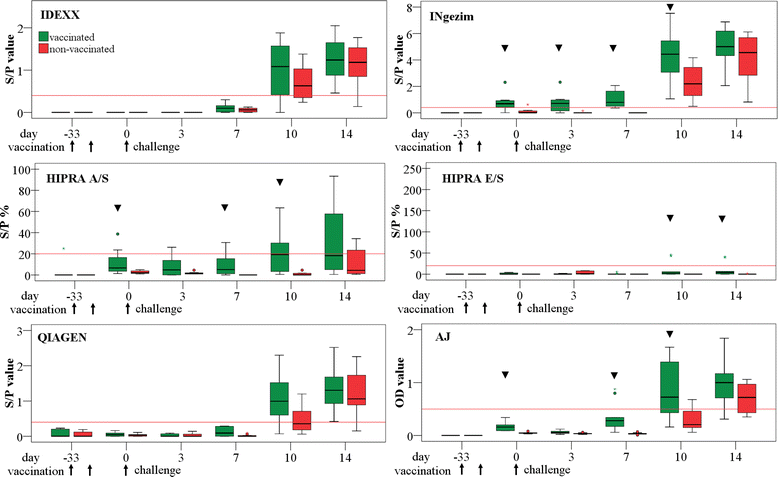Ability of ELISAs to detect antibodies against porcine respiratory and reproductive syndrome virus in serum of pigs after inactivated vaccination and subsequent challenge
- PMID: 27871292
- PMCID: PMC5117522
- DOI: 10.1186/s12917-016-0888-0
Ability of ELISAs to detect antibodies against porcine respiratory and reproductive syndrome virus in serum of pigs after inactivated vaccination and subsequent challenge
Abstract
Background: In this study, six enzyme-linked immunosorbent assays (ELISA), intended for routine porcine reproductive and respiratory syndrome virus (PRRSV) herd monitoring, are tested for their ability to detect PRRSV specific antibodies in the serum of pigs after vaccination with an inactivated PRRSV type 1 vaccine and subsequent infection with a highly pathogenic (HP) PRRSV field strain. For this reason, ten piglets (group V) from a PRRSV negative herd were vaccinated twice at the age of 2 and 4 weeks with an inactivated PRRSV vaccine. Ten additional piglets (group N) from the same herd remained unvaccinated. Three weeks after second vaccination, each of the piglets received an intradermal application of an HP PRRSV field strain. Serum samples were taken before first vaccination as well as before and 3, 7, 10 and 14 days after HP PRRSV application. All serum samples were tested for PRRSV RNA by reverse transcriptase quantitative polymerase chain reaction (RT-qPCR) as well as for PRRSV antibodies with all six study ELISAs.
Results: At the beginning of the study (before vaccination), all of the piglets were PRRSV antibody negative with all study ELISAs. They also tested negative for PRRSV RNA measured by RT-qPCR. From day 3 after HP PRRSV application until the end of the study, a viremia was detected by RT-qPCR in all of the piglets. On day 0 (day of HP PRRSV application), nine out of ten piglets of the pre-vaccinated group tested PRRSV antibody positive with one of the tested ELISAs, although with lower S/P values than after infection. On day 10 after HP PRRSV application, all study ELISAs except one had significantly higher S/P or OD values, respectively more positive samples, in group V than in group N.
Conclusions: Only one of the tested ELISAs was able to detect reliably PRRSV antibodies in pigs vaccinated with an inactivated PRRSV vaccine. With most of the tested ELISAs, higher S/P values respectively more positive samples after PRRSV infection were seen in the pre-vaccinated group than in the non-vaccinated.
Keywords: ELISA; Inactivated vaccine; PRRSV; Swine.
Figures

Similar articles
-
Efficacy of live attenuated porcine reproductive and respiratory syndrome virus 2 strains to protect pigs from challenge with a heterologous Vietnamese PRRSV 2 field strain.BMC Vet Res. 2018 Apr 19;14(1):133. doi: 10.1186/s12917-018-1451-y. BMC Vet Res. 2018. PMID: 29673363 Free PMC article.
-
Antibody response and maternal immunity upon boosting PRRSV-immune sows with experimental farm-specific and commercial PRRSV vaccines.Vet Microbiol. 2013 Dec 27;167(3-4):260-71. doi: 10.1016/j.vetmic.2013.08.017. Epub 2013 Aug 28. Vet Microbiol. 2013. PMID: 24041768
-
Performance of ELISAs for detection of antibodies against porcine respiratory and reproductive syndrome virus in serum of pigs after PRRSV type 2 live vaccination and challenge.Porcine Health Manag. 2015 Dec 11;1:19. doi: 10.1186/s40813-015-0015-9. eCollection 2015. Porcine Health Manag. 2015. PMID: 28405425 Free PMC article.
-
Comparison of two genetically distant type 2 porcine reproductive and respiratory syndrome virus (PRRSV) modified live vaccines against Vietnamese highly pathogenic PRRSV.Vet Microbiol. 2015 Sep 30;179(3-4):233-41. doi: 10.1016/j.vetmic.2015.06.013. Epub 2015 Jun 26. Vet Microbiol. 2015. PMID: 26149103 Clinical Trial.
-
The effect of a killed porcine reproductive and respiratory syndrome virus (PRRSV) vaccine treatment on virus shedding in previously PRRSV infected pigs.Vet Microbiol. 2004 Aug 19;102(1-2):11-8. doi: 10.1016/j.vetmic.2004.05.006. Vet Microbiol. 2004. PMID: 15288922
Cited by
-
Skin-Based Vaccination: A Systematic Mapping Review of the Types of Vaccines and Methods Used and Immunity and Protection Elicited in Pigs.Vaccines (Basel). 2023 Feb 16;11(2):450. doi: 10.3390/vaccines11020450. Vaccines (Basel). 2023. PMID: 36851328 Free PMC article. Review.
-
Dynamics and Differences in Systemic and Local Immune Responses After Vaccination With Inactivated and Live Commercial Vaccines and Subsequent Subclinical Infection With PRRS Virus.Front Immunol. 2019 Aug 6;10:1689. doi: 10.3389/fimmu.2019.01689. eCollection 2019. Front Immunol. 2019. PMID: 31447829 Free PMC article.
-
An intercomparison study of ELISAs for the detection of porcine reproductive and respiratory syndrome virus - evaluating six conditionally dependent tests.PLoS One. 2022 Jan 25;17(1):e0262944. doi: 10.1371/journal.pone.0262944. eCollection 2022. PLoS One. 2022. PMID: 35077518 Free PMC article.
-
A cross-sectional assessment of PRRSV nucleic acid detection by RT-qPCR in serum, ear-vein blood swabs, nasal swabs, and oral swabs from weaning-age pigs under field conditions.Front Vet Sci. 2023 Aug 10;10:1200376. doi: 10.3389/fvets.2023.1200376. eCollection 2023. Front Vet Sci. 2023. PMID: 37635762 Free PMC article.
References
-
- Cong Y, Huang Z, Sun Y, Ran W, Zhu L, Yang G, et al. Development and application of a blocking enzyme-linked immunosorbent assay (ELISA) to differentiate antibodies against live and inactivated porcine reproductive and respiratory syndrome virus. Virology. 2013;444:310–316. doi: 10.1016/j.virol.2013.06.027. - DOI - PubMed
-
- Díaz I, Venteo Á, Rebollo B, Martín-Valls GE, Simon-Grifé M, Sanz A, et al. Comparison of two commercial enzyme linked immunosorbent assays for the diagnosis of porcine reproductive and respiratory syndrome virus infection. J Vet Diagn Invest. 2012;24:344–348. doi: 10.1177/1040638711435804. - DOI - PubMed
Publication types
MeSH terms
Substances
LinkOut - more resources
Full Text Sources
Other Literature Sources
Research Materials
Miscellaneous

